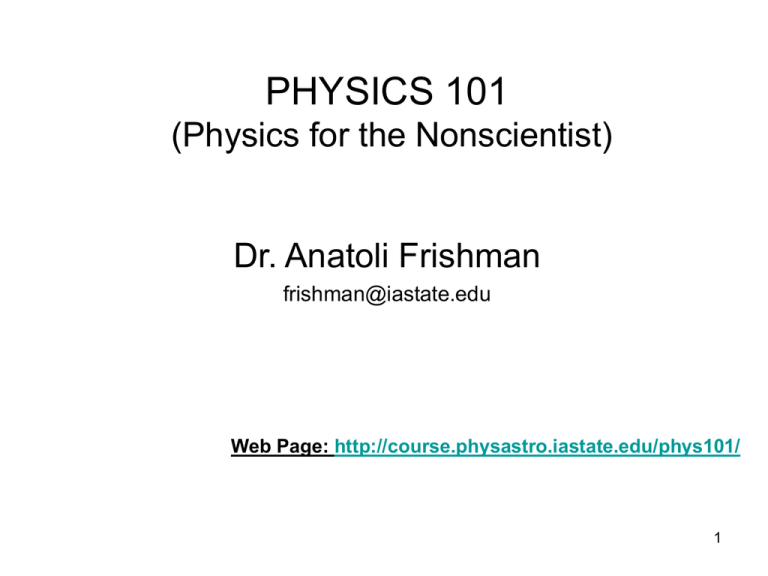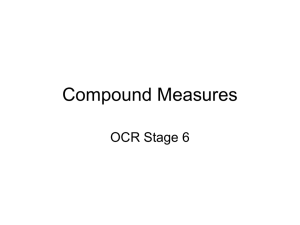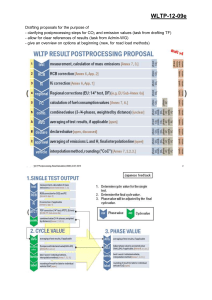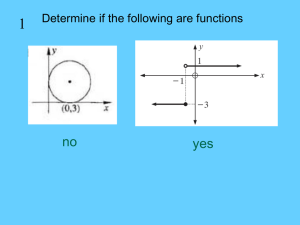lecture01
advertisement

PHYSICS 101 (Physics for the Nonscientist) Dr. Anatoli Frishman frishman@iastate.edu Web Page: http://course.physastro.iastate.edu/phys101/ 1 Introduction •What is physics? •A science •A basic science •The most basic science •Discovered by several generations of scientists •Physics and measurements •Relationships between experiments and theory •Mathematics - language of science Course organization •Lectures •Homework •Exams (multiple choice) •two midterm exams and a comprehensive final exam •Formula sheet •Syllabus 2 Physical quantities, units and standards What do we measure? - Physical quantities. Units - a unit is a measure of the quantity that is defined to be exactly 1. Examples: meter, mile, gram, kilogram. Standard - a reference to which all the other examples of the quantity are compared. Base quantities, and their standards. The International System of Units (metric system) Quantity Unit name Unit symbol Standard Length Meter m Distance traveled by light in 1/299,792,458 second Time Second s Time required for 9,192,631,770 periods of radiation emitted by cesium atoms Mass Kilogram kg Platinum-iridium cylinder in International Bureau of Weights and Measures at Sevres, near Paris 3 Other systems of units •CGSE System of Units (metric system): centimeter, gram, second 1m = 100cm 1kg = 1000g •British engineering system This system has force instead of mass as one of its basic quantities, which are feet, pounds, and seconds. 1 m = 3.281 ft; 1 inch = 2.54 cm 1 kg = 0.06585 slug (Not the same as weight!) on Earth 1 kg weighs 2.205 lb, on the Moon 1 kg weighs 0.368 lb 4 Multiples of Units 10-24 yocto- y 10-21 zepto- z 10-18 atto- a 10-15 femto- f 10-12 pico- p 10-9 nano- n 10-6 micro- 10-3 milli- m 10-2 centi- c 103 kilo- k 106 mega- M 109 giga- G 1012 tera- T 1015 peta- P 1018 exa- E 1021 zetta- Z 1024 yotta- Y Conversion of units: Multiply by the appropriate representation of 1 to cancel the unwanted units away Converting between metric units is easy, as it only involves powers of 10. Example 1: Convert 3kg into gram 1000g 3kg 3kg 3000g 1kg Example 2: Convert 10 mph into m/s 10 mile mile 1h 1609 m 10 h h 3600 s 1 mile 4.47 m/s 5 Measurements and uncertainty When we measure something, there’s a limited accuracy: result error (or accuracy) Example 1: 2.35 0.01 Example 2: Wrong: 2.35 0.1 Correct: 2.4 0.1 Significant figures Example 1: 0.24630 1sf 2sf 3sf 4sf 5sf 0.2 0.25 0.246 0.2463 0.24630 Example 2: Not so clear in some cases: 200 (1,2,3 ?) Scientific notation is crystal clear: 2 102 (or 0.2 103) 2.0 102 (or 0.20 103) 2.00 102 (or 0.200 103) 1sf 2sf 3sf 6 Physics Mechanics Thermal properties Electromagnetism •Electrostatic •Electric current •Magnetism Condensed Mater High energy Optics Atoms & particles •Geometrical optics •Wave optics Biophysics Classical physics Quantum physics Relativistic physics Quantum relativistic physics 7 MECHANICS KINEMATICS Kinematics is the study of motion, without the investigation of the cause of the motion 1. Motion •Motion of what? Material point (An object with an irrelevant dimension for the purposes of a particular problem) •Development of models Example: linear motion versus rotational •Motion is relative to the object of reference Examples: the motion of an airplane passenger relative to the airplane, or the motion of an airplane passenger relative to the ground. 8 2. One dimensional (1D) uniform motion (Motion along a straight line with a constant speed) Example: Time interval: Distance: Speed: t t final tinitial 2s d d final dinitial 10m d v t 10 m v 5m / s 2s d vt 5m / s 2s 10m If tinitial 0 and dinitial 0, then t t final t and d d final d d v t Note: In science, the capital Greek letter Δ means difference. 9 3. Speed a) Average speed: Definition: d d final dinitial v t t final tinitial (total distance over total time) b) Instantaneous speed: Definition: d v lim t 0 t Question: If the average speed is non-zero over some time interval, does this mean that the instantaneous speed is never zero during the same interval? A) Yes B) No C) It depends 10 Example 1 Given: A d1 d 2 B AB d 100km x d1 d 2 50km 2 v1 40km /h Formula used: d v t v2 60km /h v ? Solution: t1 d1 50km 5 h; v1 40km /h 4 t 2 5 5 25 h h h 4 6 12 d 100km v 48km /h t 25 / 12h d 2 50km 5 h v2 60km /h 6 t t1 t 2 Answer: v 48km /h 11 Example 2 Given: Formula used: t1 t 2 1h d v t v1 40km /h v 2 60km /h v ? Solution: d1 40km d 2 60km d d1 d 2 40km 60km 100km t 2h d 100km v 50km /h t 2h Answer: v 50 km/h 12











